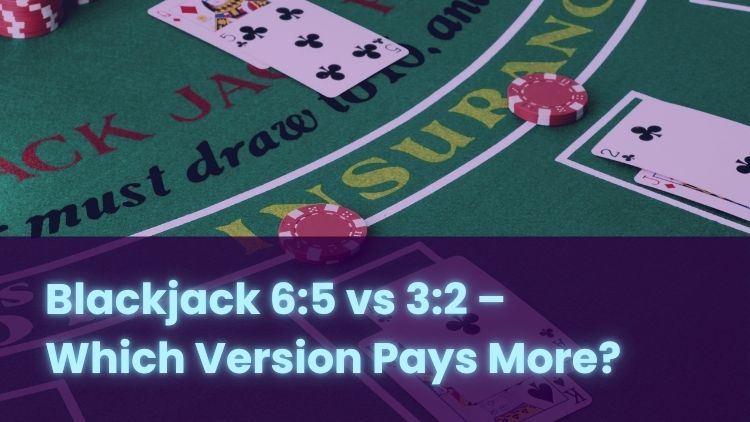
Blackjack tables in the UK can look very similar, but one small detail can make a big difference to how much you are paid if you win.
The numbers 6:5 and 3:2 printed on the felt or sign above the table refer to the payout for a blackjack hand – an Ace with any ten-value card dealt as your first two cards.
The difference between these two pay rates might seem minor at first glance, but over time it can potentially affect how much you walk away with.
This guide explains exactly what those numbers mean, how they shape the house advantage, and why it can help to spot them before you sit down.
What Do 6:5 and 3:2 Blackjack Payouts Mean?
In blackjack, the payout shows how much you receive if you win with a blackjack hand. A payout of 3:2 means you are paid one and a half times your bet. So, if you place £10 and hit blackjack, you collect £15 in winnings.
At a 6:5 table, the same £10 bet pays only £12. That is a smaller return of 1.2 times your stake.
For all other winning hands, both versions of blackjack pay 1:1 – meaning you win the same amount you wagered. A £10 standard winning hand, for instance, brings £10 in winnings in both cases. The difference only applies to blackjacks.
How Do the Different Payouts Affect Your Winnings?
Blackjack does not occur often, but when it does, the payout matters.
On average, a blackjack may appear once in every 21 hands, or about 4.8% of all deals.
If you play 100 hands at £10 each, you might hit roughly four to five blackjacks.
- At a 3:2 table, those blackjacks would pay around £60–£75 in total.
- At a 6:5 table, the same hands would pay around £48–£60.
The gap over 100 hands is about £12–£15. The more hands you play, the larger that difference may become. However, as blackjack involves an element of chance, any winnings can never be guaranteed.
House Edge in 6:5 vs 3:2 Blackjack
The house edge is the built-in advantage the casino has over players, expressed as a percentage of every £1 wagered. It is calculated over thousands of hands, not just a single session.
- With widely used UK rules and correct basic play, 3:2 blackjack typically carries a house edge of about 0.4–0.5%. That means, on average, the casino keeps around 50p from every £100 bet.
- The move to 6:5 blackjack increases the house edge to around 1.6–1.8%. Over time, that is closer to £1.70 kept by the casino for every £100 staked.
This difference of over one percentage point comes mainly from the smaller payout on blackjacks. Other rules also affect the edge, such as:
- Whether the dealer must draw on a soft 17 (Ace + 6).
- How many decks of cards are used.
- If you are allowed to double down after splitting.
- Whether surrender is offered.
Each of these details shifts the edge slightly, so it can be worth checking the paytable and rules before playing.
Why Do Casinos Offer 6:5 Blackjack?
Casinos introduce 6:5 games because they generate more revenue. A higher house edge means the casino makes more from each hand over time.
You may also notice that 6:5 is often paired with single-deck games or novelty formats. A single-deck version without the reduced payout could be too favourable for players, so the 6:5 rule offsets that.
Another reason is accessibility. 6:5 tables often come with lower minimum stakes, making them appear approachable to casual visitors. However, the trade-off is that each blackjack pays less.
Which Version of Blackjack Should You Choose?
Choosing between 3:2 and 6:5 depends on what you value. If you want the possibility of a better potential return in the long run, 3:2 is usually the stronger option because it pays more per blackjack and carries a lower house edge.
That said, some players prefer the lower-stake 6:5 tables, or may find those are the only ones available at the limits they are comfortable with. What works best will be different for each player.
Before sitting down, take a moment to read the table sign. It will show not only the potential payout, but also other rules such as how many decks are in use or whether doubling down is allowed. Understanding these rules can help you set expectations and avoid surprises.
Responsible Play
Blackjack is a game of chance, and no strategy removes that element. Even when following the best decisions, outcomes vary hand to hand. Because of this, it is important to:
- Only use money you can afford to lose.
- Decide on a spend limit before starting.
- Take breaks if you feel you need them.
- Use safer gambling tools, such as deposit caps or time reminders if you want extra support.
The choice between 3:2 and 6:5 may affect how far your money goes, but it does not guarantee how a session will end. Playing responsibly ensures the experience remains safe and manageable.
*All values (Bet Levels, Maximum Wins etc.) mentioned in relation to these games are subject to change at any time. Game features mentioned may not be available in some jurisdictions.
**The information provided in this blog is intended for educational purposes and should not be construed as betting advice or a guarantee of success. Always gamble responsibly.
